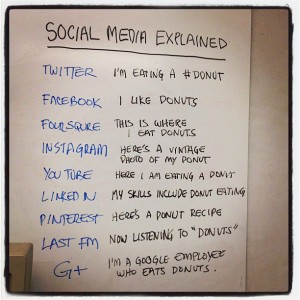Since I got involved in evaluation a few years ago, influencing stakeholders has gained a new dimension through the rise of social media.
Now politicians, celebrities, and even football-supporting cats interact every day with the public through Twitter, Facebook and more.
So how can you track and demonstrate your impact through social media? This was the title of a session I led at #barcampnfp on Friday, a day of discussions among UK non-profit techies and campaigners, organised by Voice.
And here are some of our answers:
To look at the effectiveness of social media in influencing your audiences (output level):
- Set a baseline for when you started using social media for your organisation. How quickly did you gain friends and followers? When were there spikes? How do those spikes relate to what you were sharing and how you were sharing it? How have daily interactions that the public has with you, changed?
- Use social interaction analytics tools to help you track the overall numbers of shares, retweets and mentions of you and your content. The social analytics functions in tools like Google Analytics and Hootsuite for example are free. Services like Viralheat that measure volume and impact cost more money.
- Tag your communications yourself to do some basic sentiment analysis. Why not set two categories for your communications: positive and negative. Log the numbers of every positive and negative response. Look out for mentions of ‘love,’ ‘hate’ as examples. There are many tools out there that will offer to do this, but these tend not to be cost-effective.
- Go one step further and classify your asks and statements by tone (emotive, fact-based, celebrity-endorsed) and topic (civil liberties, climate change, older people).
- It’s difficult to track sentiments or friend and follower ‘influence’. Tools like Klout have their own algorithm based on their own terms. When campaigning for change, influence depends on more than just an algorithm.
To look at campaign effectiveness, and within that social media effectiveness (outcome level):
- Note the reactions of campaign targets to your social media outputs. Does this correspond with a spike in traffic around your hashtag? How does it compare with other campaigning organisations?
- Write out a list of topics related to your campaign objectives and run searches on mentions of them among your campaign targets, classifying these as positive or negative.
- If you are running a behaviour change campaign, create tangible ‘indicators of success’ for your campaign objectives and review the positive and negative mentions of these. For example, if your campaign objectives are based on changing attitudes towards mental health, why not select a sub-topic of mental health hatecrimes.
And some tips of what you can do with this data:
- Share it with your team, and share the important bits with your senior management.
- Stop having social media campaigns and start having social media relationships. Use it to inform your regular communications with friends and followers, and to shape user experience of your other digital presences. The Nike+ GPS running app shares the data from people’s runs to Facebook, allowing Facebook friends to cheer you on.
- Use this data to tell campaign targets how many people have supported your campaign through social media.
- Use these relationships to ask friends and followers for support from their friends and followers – at least you are being honest.
- Gather stats on the Return on Investment (ROI) of social media to make your internal case for further investment. One fundraising organisation found that 40% of its friends and followers have donated to it at some point, and that the average value of a Facebook share of its own content was £6.
Although it might seem to complicate evaluation, taking the time to investigate your interactions and the ripples you create through social media can add quality to the evidence you capture, to show you are really making a difference.
You can download a Pdf of this blog post here.
